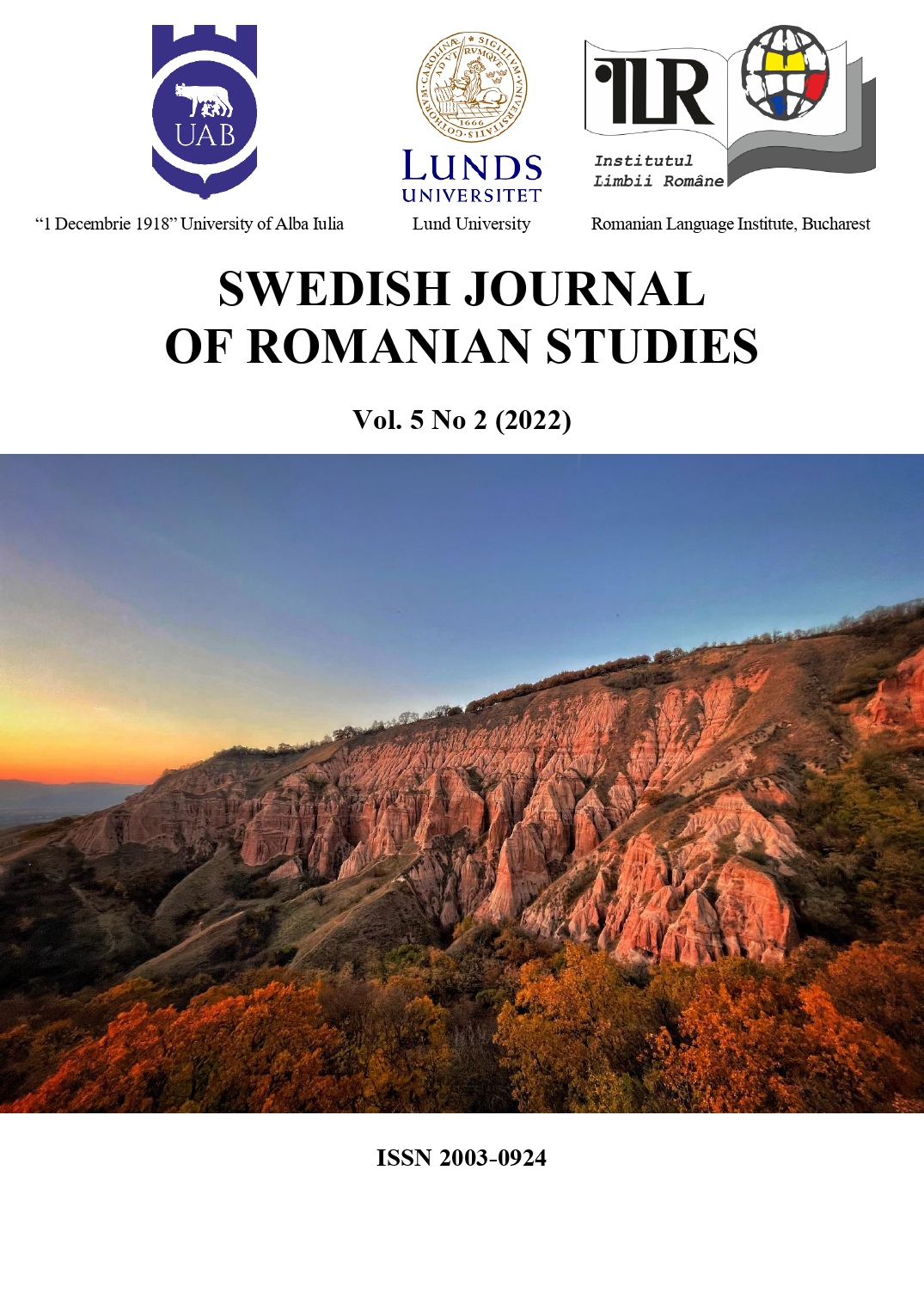Slavic elements in the calendar rites of the Romanians of Bukovina
DOI:
https://doi.org/10.35824/sjrs.v5i2.23625Keywords:
calendar rites, Bukovyna, Romanians оf Bukovyna, acculturation, Slavic elementsAbstract
This study is aimed at identifying the most noticeable Slavic elements in the calendar rites of Bukovyna. It analyzes material collected by Romanian researchers in the second half of the 19th – early 20th century (E. Niculiță-Voronca, T. Pamfile, L. Bodnărescu, А. Fochi, A. Zașciuc), documents from the Central Scientific Archive of the Academy of Sciences of the Republic of Moldova, the New Linguistic Atlas of Romania, Moldova and Bukovyna (1987), as well as personal observations recorded by the authors of the study in Ukraine and Romania during ethnographic expeditions. In the calendar rites of the Romanians of Bukovyna, some clear Slavic elements can be identified, such as some names of calendar holidays, Ukrainian elements in such rites as koliada, the Christmas star, shchedruvannya. Ukrainian motifs of musical folklore in winter rites, as well as the use of the names of Ukrainian opryshky and haidamaky, the adaptation of the “walking with vertep”, the use of the term vidma of Ukrainian origin, the penetration of the name and main text of the Ukrainian Malanka, etc.
References
Bodnărescu, L. (1908). Câteva datini de paşti la români. Încondeiatul ouălelor de paşti în culori/ Several Easter customs of Romanians. Dyeing of Easter eggs. Cernăuţi: Editura autorului.
Bostan, G. (1985). Typologhycheskoe sootnoshenye y vzaymosviazy moldavskoho, russkoho i ukraynskoho folklora/ Typological correlation and interrelations of Moldavian, Russian and Ukrainian folklore/ Typological relationship and connections of Moldavian, Russian and Ukrainian folklore. Chișinău: Ştiinţă.
Bostan, G. (1987). Moldavsko-russko-ukraynskye folklornye vzaymosviazy kontaktnykh zon (v kontekste ystorycheskoi rodstvennosty ustno-poetycheskykh tradytsyi): avtoref. dys. na soyskanye uchennoi stepeny doktora filol. nauk: spets. 10.01.09 – “Folklorystyka”/ Moldovan-Russian-Ukrainian folklore interconnections of contact zones (in the context of the historical kinship of oral-poetic traditions): author. dis. for the degree of Doctor of Philol. Sciences: spec. 10.01.09 – “Folkloristics”/ Moldovan-Russian-Ukrainian folklore interconnections of contact zones (in the context of the historical kinship of oral-poetic traditions): thesis abstract for the degree of Doctor of Philology: branch 10.01.09 – “Folklore studies”. Moscow.
Bostan, Gr. (1998). Poezia populară românească în spaţiul Carpato-Nistrean. Istoriografie, studiu comparat, texte/ Romanian folk poems in the Karapato-Dniester area. Historiography, comparative studies, texts. Iaşi: Cantes.
Fochi, A. (1976). Datini şi eresuri populare de la sfârşitul secolului al XIX: Răspunsurile la chestionarele lui Nicolae Densuşianu/ Folk customs and superstitions in the late XIX century: answers to questionnaires N. Densuşianu. Bucureşti: Minerva.
Kojoleanco, G. (1999-2004). Etnohrafiia Bukovyny/ Ethnography of Bukovyna/ Ethnography of Bukovyna. Chernivtsi: Zoloti Lytavry, V. 1–3.
Kurochkin, O. (1995). Ukrainski novorichni obriady: “Koza” i “Malanka” (z istorii narodnykh masok)/ Ukrainian New Year's rites: "Goat" and "Lightning" (from the history of folk masks)/ Ukrainian New Year's rites: “Goat” and “Malanka” (from the history of folk masks). Opishnia: Publishing House of the National Museum-Reserve of Ukrainian Pottery in Opishnia.
Moysey, А. (2010). Agrarni zvychai ta obriady u narodnomu kalendari skhidnoromanskoho naselennia Bukovyny/ Agrarian customs and rites in the folk calendar of the eastern Romanian population of Bukovyna/ Agrarian customs and rites in the folk calendar of the Eastern Romance population of Bukovyna. Chernivtsi: “Druk Art”.
NALR, 1987: Noul Atlas lingvistic al României. Moldova şi Bucovina. Date despre localităţi şi informatori/ New linguistic atlas of Romania. Moldova and Bukovyna. Data on settlements and informants. Alcăt. de V. Arvinte, S. Dumistrăcel, I. Florea, I. Nuţă, A. Turculeţ. Bucureşti: Editura Academiei Republicii Socialiste Române.
Niculiţă-Voronca, E. (1998). Datinele şi credinţele poporului român/ Romanian folk rites and beliefs; ed. îngr. de V.Durnea. Iaşi: Polirom, Vol. I-II.
Pamfile, T. (1916-1924). Mitologie românească. După credinţele poporului român/ Romanian mythology. According to the beliefs of the Romanian people. Bucureşti: Academia Română, Vol. I-III.
TsNAANRM, 1971 : Tsentralnyi naukovyi arkhiv Akademii nauk Respubliky Moldova/ Central Scientific Archive of the Academy of Sciences of the Republic of Moldova/ Central Scientific Archive of the Academy of Sciences of the Republic of Moldova. Fund 19, Ref. № 238. Moldavskyi folklor zibranyi u selakh: Kolinkivtsi, Rakytna, Dynivtsi, Shyshkivtsi Chernivetskoi obl. USSR. Zibraly: I. Ciobanu, N. Băieșu/ Moldovan folklore is collected in the villages: Kolinkivtsi, Rakytna, Dynivtsi, Shyshkivtsi, Chernivtsi region. USSR. Collected by: ID Choban, N. Beeshu/ Moldovan folklore, collected in the villages: Kolinkivtsi, Rokytne, Dynivtsi, Shyshkivtsi of Chernivtsi region. UkSSR. Collected by: I. Ciobanu, N. Băieșu.
Zasciuc, A. (1862). Bessarabskaia oblasty: Materyaly dlia gheografyy i statystyky Rossyy, sobrannye ofytseramy gheneralnoho shtaba/ Bessarabian region: Materials for geography and statistics of Russia, collected by officers of the General Staff/ Bessarabian oblast: Materials for geography and statistics of Russia, collected by officers of the general staff. St. Petersburg.
Downloads
Published
How to Cite
Issue
Section
License
Copyright (c) 2022 Antoniy Moysey, Antonina Anistratenko, Tetyana Nykyforuk

This work is licensed under a Creative Commons Attribution-NonCommercial 4.0 International License.
Authors who publish with this journal agree to the following terms:
a. Authors retain copyright and grant the journal right of first publication with the work simultaneously licensed under a Creative Commons Attribution-NonCommercial 4.0 International License that allows others to share the work with an acknowledgement of the work's authorship and initial publication in this journal.
b. Authors are able to enter into separate, additional contractual arrangements for the non-exclusive distribution of the journal's published version of the work (e.g., post it to an institutional repository or publish it in a book), with an acknowledgement of its initial publication in this journal.
c. Authors are permitted and encouraged to post their work online (e.g., in institutional repositories or on their website) prior to and during the submission process, as it can lead to productive exchanges, as well as earlier and greater citation of published work (See The Effect of Open Access).

